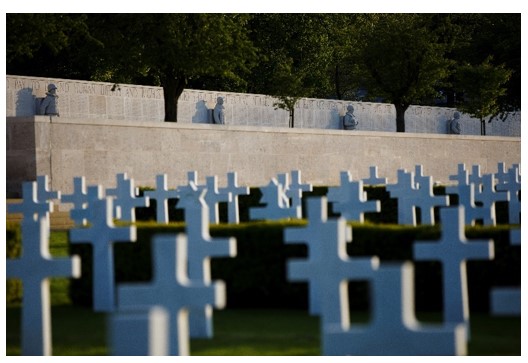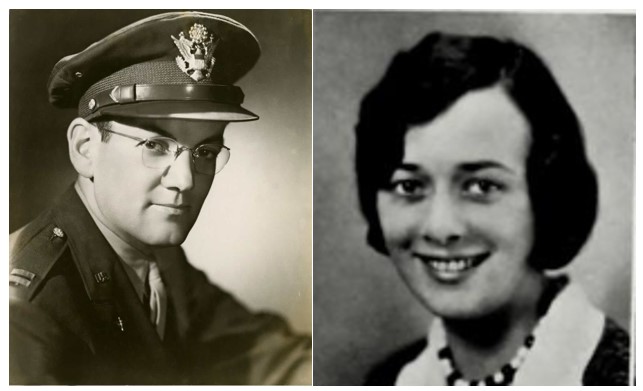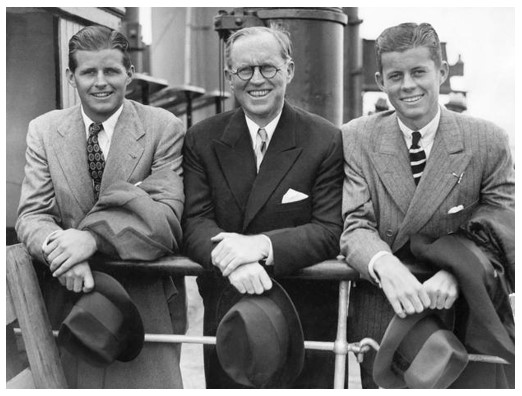Cambridge American Cemetery is the only World War II cemetery in the U.K. and is located on the outskirts of the university city of Cambridge. It was a temporary cemetery during the war and commonly described as the “aviator’s cemetery” or the “Eighth Air Force Cemetery,” due to the many surrounding airfields.
A close relationship with the University of Cambridge
During the war, Cambridge had been the site of one of three temporary cemeteries in the U.K. Maj. Gen. John C. H. Lee thought the site so special that he suggested its use as a permanent cemetery. The British were so grateful for the help of the U.S. during World War II, that they would not let America buy the land, and thus, it was donated by the University of Cambridge. It is lasting proof of the special and enduring relationship between the U.S. and the U.K.

The size of the Wall of the Missing
Cambridge American Cemetery has the longest Wall of the Missing of any of the World War II American cemeteries in Europe. At nearly 500 feet long, it is inscribed with the names of 5,126 men and one woman. There are more people whose names are inscribed there than there are burials (3,811) at the cemetery.
The main reasons that it is so long are reflected in the operations it represents: the Battle of the Atlantic; the strategic air war; and the tragic loss of life at Slapton Sands, Devon during Exercise Tiger. It could possibly be longer, but, for example, some downed aircrews are split between Cambridge American Cemetery and other American Battle Monuments Commission sites in mainland Europe.

The Battle Map
They say a picture is worth a thousand words. This is especially true of the battle map displayed in the memorial. It depicts operations in North Africa, Italy and finally Normandy. It is the perfect visual explanation of the U.S. involvement in the European Theater.
The map is a bas relief created out of different hued marbles to indicate higher ground. Titled “The Mastery of the Atlantic – The Great Air Assault,” it was designed by American artist Herbert Gute, and subsequently executed by the David Kindersley stone workshops in Cambridge.

A Band leader commemorated on the Wall of the Missing
U.S. Army Air Force band leader Maj. Alton G. Miller disappeared while flying over the English Channel in a single-engine aircraft. Generally known by his stage name, Glenn Miller, the famous musician was promoted to major at the Bedford American Red Cross Club (ARC). ARC hostess and Miller’s friend, Emily Harper Rae was chosen to present him with his major’s oak leaves and in return received his captain’s bars as a keepsake.
When Rae’s plane crashed on the mountains of the Isle of Man, during a flight from Paris to Northern Ireland, both she and her pocketbook were recovered. Inside her purse was a set of captain’s bars. We are led to believe that these belonged to Miller and are buried with her.
Miller is commemorated on the Wall of the Missing at Cambridge American Cemetery.

The Kennedy legacy
Joseph “Joe” was the eldest of the Kennedy’s nine children. His politically ambitious father was grooming him to become the first Roman Catholic president of the U.S. when World War II intervened. Joe volunteered for U.S. Navy service, as did his younger brother John, both prior to America’s entry into the fray. They were joined by brother Robert in 1943.

Joe became a Navy aviator and sub-hunter, flying first in the Caribbean and later with British Coastal Command. He volunteered for a top secret and highly dangerous mission. It was called Operation Anvil, and on Aug. 12, 1944, his target was the Mimoyecques V-3 rocket launch site in northern France. In a war-weary B-24 Liberator, packed with explosives, he and his engineer set off from East Anglia. Once on course the skeleton crew would safely bail out and the aircraft fly on as a drone to crash into the target. Unfortunately, there was a premature detonation, and with a massive explosion both men were killed – their names can be found on the Cambridge American Cemetery Wall of the Missing.

His family was distraught. When taking tours with younger visitors guides often use the Kennedy story as an example of families torn apart by war. Joe was the first-born son; the much looked up to elder brother for eight siblings. John went on to become president of the U.S.
Cambridge American Cemetery lies on a slope with the west and south sides framed by woodland. The cemetery contains the remains of approximately 3,800 U.S. service members. Another approximately 5,100 names are recorded on the Walls of the Missing. Rosettes mark the names of those since recovered and identified.
ABMC sites are a constant reminder of Gen. John J. Pershing’s promise that “time will not dim the glory of their deeds.”
Sources:
Cambridge American Cemetery’s team
ABMC Historical Services
ABMC website and brochures
 An official website of the United States government. Here's how you know.
An official website of the United States government. Here's how you know. 